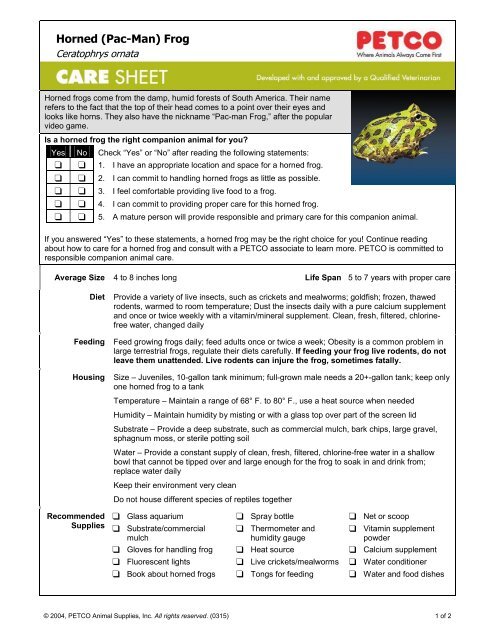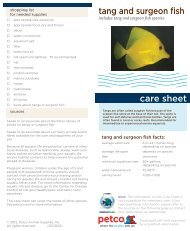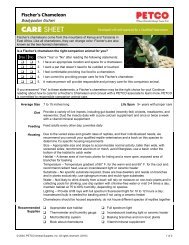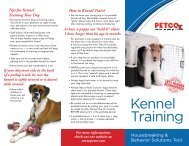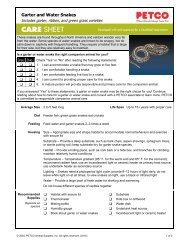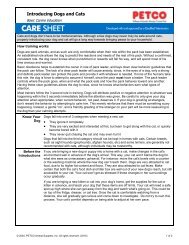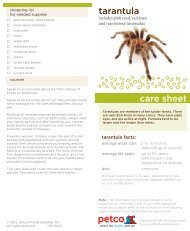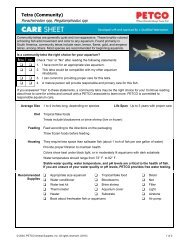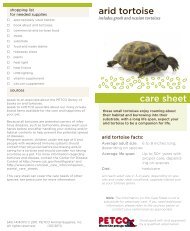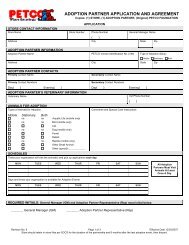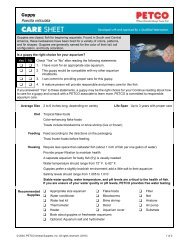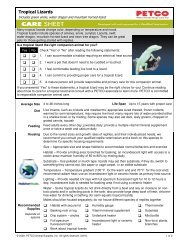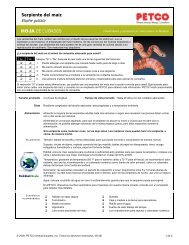Horned (Pac-Man) Frog - Petco
Horned (Pac-Man) Frog - Petco
Horned (Pac-Man) Frog - Petco
You also want an ePaper? Increase the reach of your titles
YUMPU automatically turns print PDFs into web optimized ePapers that Google loves.
<strong>Horned</strong> (<strong>Pac</strong>-<strong>Man</strong>) <strong>Frog</strong>Ceratophrys ornata<strong>Horned</strong> frogs come from the damp, humid forests of South America. Their namerefers to the fact that the top of their head comes to a point over their eyes andlooks like horns. They also have the nickname “<strong>Pac</strong>-man <strong>Frog</strong>,” after the popularvideo game.Is a horned frog the right companion animal for you?Yes No Check “Yes” or “No” after reading the following statements:❑ ❑ 1. I have an appropriate location and space for a horned frog.❑ ❑ 2. I can commit to handling horned frogs as little as possible.❑ ❑ 3. I feel comfortable providing live food to a frog.❑ ❑ 4. I can commit to providing proper care for this horned frog.❑ ❑ 5. A mature person will provide responsible and primary care for this companion animal.If you answered “Yes” to these statements, a horned frog may be the right choice for you! Continue readingabout how to care for a horned frog and consult with a PETCO associate to learn more. PETCO is committed toresponsible companion animal care.Average Size 4 to 8 inches long Life Span 5 to 7 years with proper careDietFeedingHousingRecommendedSuppliesProvide a variety of live insects, such as crickets and mealworms; goldfish; frozen, thawedrodents, warmed to room temperature; Dust the insects daily with a pure calcium supplementand once or twice weekly with a vitamin/mineral supplement. Clean, fresh, filtered, chlorinefreewater, changed dailyFeed growing frogs daily; feed adults once or twice a week; Obesity is a common problem inlarge terrestrial frogs, regulate their diets carefully. If feeding your frog live rodents, do notleave them unattended. Live rodents can injure the frog, sometimes fatally.Size – Juveniles, 10-gallon tank minimum; full-grown male needs a 20+-gallon tank; keep onlyone horned frog to a tankTemperature – Maintain a range of 68° F. to 80° F., use a heat source when neededHumidity – Maintain humidity by misting or with a glass top over part of the screen lidSubstrate – Provide a deep substrate, such as commercial mulch, bark chips, large gravel,sphagnum moss, or sterile potting soilWater – Provide a constant supply of clean, fresh, filtered, chlorine-free water in a shallowbowl that cannot be tipped over and large enough for the frog to soak in and drink from;replace water dailyKeep their environment very cleanDo not house different species of reptiles together❑ Glass aquarium ❑ Spray bottle ❑ Net or scoop❑ Substrate/commercialmulch❑ Thermometer andhumidity gauge❑ Vitamin supplementpowder❑ Gloves for handling frog ❑ Heat source ❑ Calcium supplement❑ Fluorescent lights ❑ Live crickets/mealworms ❑ Water conditioner❑ Book about horned frogs ❑ Tongs for feeding ❑ Water and food dishes© 2004, PETCO Animal Supplies, Inc. All rights reserved. (0315) 1 of 2
<strong>Horned</strong> (<strong>Pac</strong>-<strong>Man</strong>) <strong>Frog</strong>Ceratophrys ornataNormalBehavior andInteractionSedentary, aggressive, gluttonous, and cannibalistic when given the chance; awake duringthe day; can overpower and swallow prey almost its own sizeHave very delicate skin which can be harmed by oils from human hands; handle with glovesShed periodically; after their skin is shed, they will eat itHabitatMaintenanceUse an appropriate sized, small-mesh, soft net to move or block the frog while doing habitatmaintenance; avoid handling; if you handle them be sure to wear latex gloves; residue or oilon your skin can harm amphibiansThoroughly clean the tank at least once a week: set frog aside in a secure habitat; scrub thetank and furnishings with a 3% bleach solution; rinse thoroughly with water, removing all smellof bleach; dry the tank and furnishings; and add clean substrateChange the water bowl after every visit, using water without chlorine or other additivesGroomingand HygieneSigns of aHealthy AnimalCommonHealth IssuesInspect skin for abrasions or signs of parasites, infection, or diseaseHandle frogs as little as possible; always wash your hands before and after touching yourhorned frog or habitat contents to help prevent Salmonella and other infectious diseases Eats regularly Healthy skin; clear eyes Active and alert Maintains weight; avoids obesityHealth Issue (alpha) Symptoms or Causes Suggested ActionChemicalIntoxicationIntestinalObstructionNutritionalDeficienciesSkin ProblemsCaused by exposure to soap,detergent, pesticides, etc.Caused by swallowing gravelor by eating too many hardshelledinsects.Weak hind legs, lethargy,lighter or darker skin color.Abrasions, bacterial andfungal infections.May be lethal; be sure to protectyour frog from exposure.Consult with an exotic animalveterinarian; surgery may berequired.Ensure a varied diet; use vitaminand mineral supplements. Consultwith an exotic animal veterinarian.Consult with an exotic animalveterinarian for treatment.Red Flags Lethargy Skin lesions Loss of appetite Distressed breathing Weight loss Weak leg movements Bloated abdomenIf you notice any of these signs, please contact your exotic animal veterinarian.Sources<strong>Horned</strong> <strong>Frog</strong>s by R. HunzikerThe General Care and Maintenance of <strong>Horned</strong> <strong>Frog</strong>s by Philippe De VosjoliThe <strong>Horned</strong> <strong>Frog</strong> Family and African Bullfrogs (Reptile Keepers Guide) by Richard D. Bartlett,Patricia Pope BartlettNote: The information on this Care Sheet is not a substitute for veterinary care. If you need additionalinformation, please refer to the above sources or contact your veterinarian as appropriate.2 of 2 SKU 942383 © 2004, PETCO Animal Supplies, Inc. All rights reserved. (0315)


